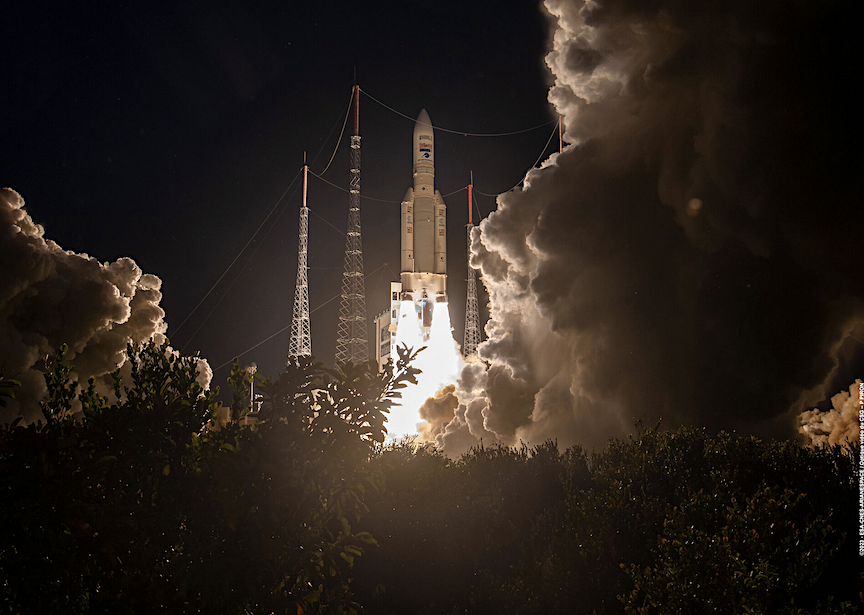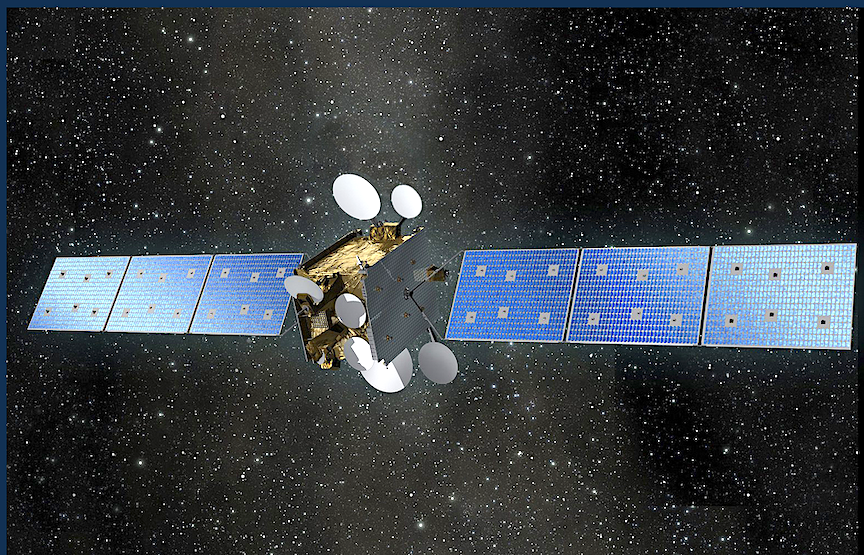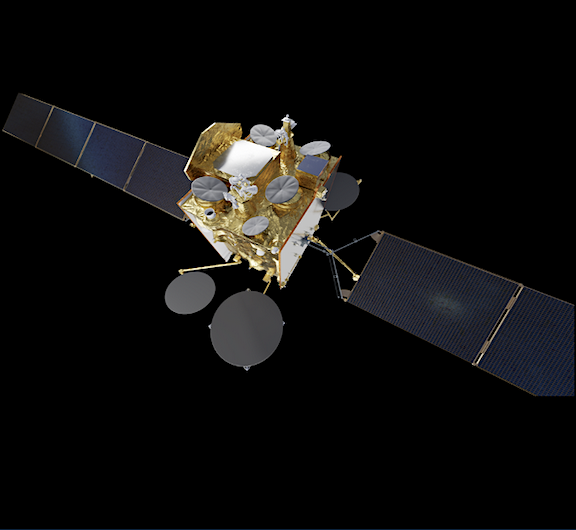
On July 5, 2023 at 7:00 p.m. local time, Ariane 5, operated by Arianespace, lifted off flawlessly from Europe’s spaceport in Kourou, French Guiana, carrying Heinrich-Hertz-Satellit for the German government and SYRACUSE 4B for the French Ministry of Defence.
The Heinrich-Hertz-Mission is the first dedicated German telecommunications satellite-based mission that will be used to conduct research and to test new technologies and telecommunications scenarios. The technologies on board are meant to respond smartly and flexibly to future challenges, to support future telecommunications scenarios and to be adapted from Earth to address new technical requirements and market needs. The mission is managed by the German Space Agency on behalf of the German Federal Ministry for Economic Affairs and Climate Action (BMWK) and with the participation of the German Federal Ministry of Defence (BMVg). The Heinrich-Hertz-Satellit was mainly developed and built by OHB System.

The SYRACUSE 4B satellite is part of the SYRACUSE IV program carried out under the leadership of the DGA in collaboration with the French Air and Space Force, and for the Space Command (CdE). Together with SYRACUSE 4A, it will enable French armed forces to remain permanently connected when they are deployed on operations. At sea, in the air, or on land, the armed forces need powerful and secure communications systems to be able to exchange information with theIr command center. Thanks to state-of-the-art equipment including an anti-jamming antenna and a digital onboard processor, SYRACUSE 4B will be fully protected against the most severe military threats. It will help guarantee French national sovereignty while also supporting NATO operations. Airbus Defence and Space and Thales Alenia Space joined forces to develop the SYRACUSE 4A and SYRACUSE 4B satellites so that the program could benefit fully from their combined expertise.
“This 117th and last Ariane 5 mission is emblematic in several respects. Ariane 5 has just deployed two telecommunications satellites, SYRACUSE 4B and Heinrich-Hertz-Satellit, for France and Germany, the first two contributors to the Ariane program,” said Stéphane Israël, CEO of Arianespace. “This mission is also emblematic of Ariane 5’s ability to perform dual launches, which constitutes the very core of its success, with 197 satellites placed in geostationary orbit out of a total of 239 satellites deployed. Over its career, Ariane 5 has served 65 institutional and commercial customers from 30 countries. Ariane 5’s success heralds a promising career for Ariane 6.”

This launch also marks the end of the remarkable career of the HM7 upper stage engine, which flew on the first Ariane 1 and on the final Ariane 5. It helped power Ariane launchers 228 times, without ever failing. This veteran of spaceflight has been a crucial element in the European space adventure. It will be replaced on Ariane 6 by the re-ignitable Vinci engine.
“Ariane 5 is now taking its place in the annals of global space history. This final successful mission demonstrates once again its supreme reliability in the service of European autonomy and rounds off an exceptional career distinguished by a succession of technological and industrial achievements. I share the emotion of all the employees at ArianeGroup, Arianespace, the French and European space agencies CNES and ESA, and all our European partners, who have contributed to its success over the course of these 27 years,” said Martin Sion, CEO of ArianeGroup. “Together we are now taking up the challenge of Ariane 6, the beneficiary of the experience acquired with Ariane 5. It will be able to evolve and play a full role in guaranteeing independent, sustainable access to space for Europe, in a context of major strategic, economic and environmental challenges, to meet the needs of its institutional and commercial customers.”

Leading up to its inaugural flight, Ariane 6 is currently passing a series of key milestones in Europe and in French Guiana. Even more versatile and competitive, Ariane 6 will carry out its first missions with a rapid production ramp-up, supporting Europe’s institutional missions and meeting the swiftly growing demands of the commercial market.
The Ariane 5 heavy-lift launcher is an ESA program carried out in cooperation between public institutions and industry across 12 European partner states.
ArianeGroup is the lead contractor for the development and production of the Ariane family of launchers. It is responsible for Ariane 5 and Ariane 6 preparation operations up to lift-off. ArianeGroup is at the head of a vast industrial network of more than 600 companies, including 350 small and medium-size enterprises (SMEs). ArianeGroup delivers a flight-ready launcher on the launch pad to its subsidiary Arianespace, which markets and operates Ariane 5 from Europe’s spaceport in French Guiana. During Ariane 5 launch campaigns, Arianespace works closely with the French space agency (CNES), the design authority for the launcher and responsible for the satellite preparation facilities and the launch base.
Flight VA261 will carry to space two payloads — the German space agency DLR’s experimental communications satellite Heinrich Hertz and the French communications satellite Syracuse 4b.

The flight will be the 117th mission for Ariane 5, a series which began in 1996. Notable Ariane 5 payloads have included; ESA’s comet-chasing Rosetta; a dozen of Europe’s Galileo navigation satellites orbited with just three launches; and the NASA/ESA/CSA James Webb Space Telescope. Ariane 5’s next-to-last launch sent ESA’s Juice mission to Jupiter.
This heavy launcher more than doubled the mass-to-orbit capacity of its predecessor, Ariane 4, which flew from 1988 until 2003 as a favorite of the telecommunications industry with its need to put large payloads into very high geosynchronous orbits. Ariane 5’s capacity enables it to orbit two large telecommunications satellites on a single launch, or to push large and heavy payloads into deep space as the need for global communications bandwidth rapidly increases, so do the demands on communications satellites. Communications satellites capable of handling modern and future demands
must therefore make use of increasingly high-performance technologies. The Heinrich Hertz mission is the first dedicated German communications satellite for researching and testing new technologies and
communications scenarios.
The technologies on board will respond smartly and flexibly to future satellite communications challenges, support future communications scenarios and be adapted from Earth to address new technical requirements and market conditions.
The mission is making an important contribution to the information society in Germany. The Heinrich Hertz mission is managed by the German Space Agency at DLR in Bonn on behalf of the German Federal Ministry for Economic Affairs and Climate Action (BMWK), with the participation of the German Federal Ministry of Defence (BMVg). OHB-System AG was contracted to develop and build the satellite. A total of 42 partners are participating in the mission, of which 14 are involved in the scientific payload
Ordered by the French defense procurement agency (DGA), this satellite will enable the French Armed Forces to remain permanently connected during deployments. Whether at sea, in the air or on land, military personnel need powerful, secure communications to exchange information with the command center. Thanks to state-of-the-art equipment (anti-jamming antenna, digital processor, etc.), SYRACUSE 4B will be totally protected against the most extreme jamming methods. Built to defend French sovereignty, the satellite will also be able to support operations led by NATO and the EU.
The SYRACUSE IV military telecommunications satellite system, comprising 2 satellites, SYRACUSE 4A and 4B, is being built for the DGA by an industrial consortium formed by Thales Alenia Space and Airbus Defence and Space. Thales Alenia Space is responsible for the SYRACUSE 4A satellite, based on its 100% electric SpaceBus Neo platform, and for the two payloads.
Airbus Defence and Space is responsible for the SYRACUSE 4B satellite, based on the all electric version of the Eurostar platform, and supplies critical elements of both payloads Thales Alenia Space is the lead contractor responsible for relations with the French Ministry for the Armed Forces.
.
